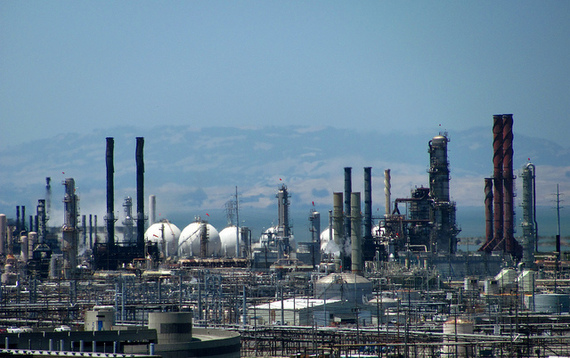By Tim O’Connor with Larissa Koehler and Jorge Madrid
EPA recently proposed a final pollution reduction rule for refineries that will help cut toxic air emissions and improve monitoring at the nation’s largest industrial facilities. This new rule is an important complement to the state level carbon and air pollution limits we have in California, and together will make our state cleaner, healthier, and more prosperous.

Source: flickr/Jason Holmberg, Richmond, CA
Any doctor will tell you that to fight the toughest diseases you often need a combination of treatment options. The clean air laws we have in California are an indispensable part of the cure for our air pollution problems. But to be fully effective, they need complementary policies from Washington.
Central to the challenge is the fact that large refineries are all too often found in disadvantaged communities – and release greenhouse gases, carcinogens, neurotoxins, and hazardous metals. Even though our state has been regulating refineries for decades, millions of Californians are still exposed to dirty, dangerous air. The puzzle of how to protect our communities is still missing pieces.
What is needed is direct federal attention to oil refineries. With an EPA standard that is based on the most up-to-date pollution control technology and a new health impact analysis, we can cut pollution and ensure the communities living next to refineries have healthier air and more information about what they’re breathing.
Cleaning up refineries will also have a positive impact on climate change. Research shows that reducing non-carbon pollution from refineries will also create carbon reductions because most solutions require more efficient equipment, better energy management, and modernized industrial processes. According to the U.S. EPA, the new proposed final refinery rule will cut 5,600 tons per year of toxic air pollutants and 52,000 tons per year of smog forming VOCs while also reducing 700,000 metric tons of CO2 nationwide.
EPA’s role in the refinery pollution puzzle
EPA’s new rule is an important step in the right direction for refineries because it will require toxic air pollution reductions, increased fence line monitoring, and improved public health impact analysis. EPA’s rule, however, can be further strengthened by addressing the refining industry shift towards processing dirtier crude oils and the need for improved safety systems across the board. As stated in EDF’s testimony at a public hearing earlier this month in the Los Angeles area, robust EPA standards, can provide a needed backbone for community protection in some of California’s most polluted cities.
Refiners may say they can’t clean up their pollution, yet the data and history prove otherwise.
Make no mistake, new regulations on petroleum producers will continue to be met with stiff opposition – even though significant evidence shows that opportunities to cut pollution and modernize equipment exist and have occurred in the past. Case in point: in support of the merger of the Tesoro and BP refineries in Wilmington, California, Tesoro Executive Vice President of Operations Daniel Robert Romasko said this at a 2013 investor conference:
“So let me talk about the regulatory environment, specifically about AB 32… If we take a look at the stationary source CO2 requirements, we expect those costs to be manageable as we move forward… it’s not a particularly material problem for us. And that’s before we come up with the creative solutions like integrating with BP Carson, and decrease our emissions by 0.5 million tons per year. So we don’t see stationary-source emissions as a particular problem.”
(Excerpt received from Seeking Alpha)
Similarly, in October 2013, a report from NRDC found that continual improvements in the efficiency of U.S. refineries could reduce energy use by 13 percent by 2020 through adapting commercially available technologies. This sector’s potential for energy efficiency is as high as 26 percent if best practices and state-of-the-art technologies are used.
Along the same lines, a May 2014 report from Bloomberg had this to say about Shell refining:
“Royal Dutch Shell Plc (RDSA), Europe’s biggest oil company, is considering retiring one of two coking units at its only refinery in California as the company… a move that would shrink the plant’s reliance on heavy oils and cut its greenhouse-gas emissions by 15 percent.”
This past March, Chevron, California’s largest oil company recorded over 70,000 tons per year worth of carbon reductions with the San Joaquin Valley Air Pollution Control District from a single project that modified operations at oil production facilities in Kern County. (This is notwithstanding the fact that Chevron was also fined $364,500 for reporting incorrect greenhouse gas emissions information from operations at its El Segundo Refinery.)
EPA and California can work together to create an interlocking community protection framework
The EPA rule is only one of many interlocking pieces needed to provide cleaner air in our communities. To be effective, measures such as strong federal mandates, state rules that require efficiency audits for refineries, and state rules that incentivize efficiency upgrades by limiting greenhouse gas emissions need to work in tandem.
Citizens in California and across the nation deserve a better environment, and policymakers from both federal and state government owe it to them to do their utmost to enact robust and comprehensive policies.
If you would like to learn more about the proposed final refinery rules, please visit the U.S. EPA website, or read EDF’s testimony.









